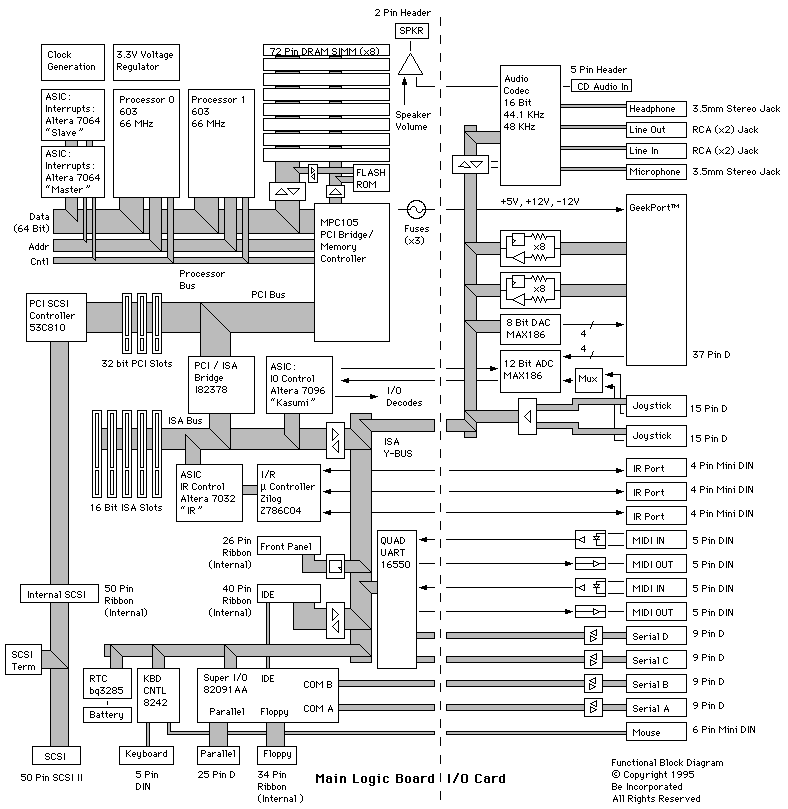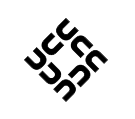BeBox (n; plural BeBoxen)
A Box manufatured by the company Be Inc.UCC has two BeBoxen, a revision 6 production model called magenta and a pre-release rev 5 prototype model which has no name (referred to as PPC95111000 through this article) which has never had a front bezel. Magenta is believed to be stored in the clubroom somewhere, while PPC95111000 is currently with AlexDawson for advanced hardware diagnostics and repairs.
Be Inc. was started in 1990 by Jean Louis Gasse, an early Apple pioneer. The company became defunct in 2001. For more information about the company, please see Be Inc. (Wikipedia). As of 2018, they are the last company to attempt to enter the home PC market with their own hardware and OS, and are considered an example not to follow.
These machines utilise dual PowerPPC 603 CPUs and were considered far ahead of their time. Be Inc developed their own operating system, intially only for PowerPC but was later ported to other platforms, which was called BeOS.

The big problem they had was that they irritated their developers due to the brittle base class problem. They broke ABI a lot – even if your program would compile without changes, it still needed recompilation and redistribution to users. Pre-ubiquitous-fast-internet connections, that was ridiculously impractical. - Grahame Bowland, 1/04/2012
[...] Those guys were way ahead of their time. Database-based filesystems with indexing and searching; ubiquitous threading and multi-processor support; metadata mania; the whole works. It's only in the last few years that we've started to get the sorts of functionality they had back then. - Daniel Axtens, 31/03/2012
General BeBox Software Notes
IDE CD drives supported as of DR9 - https://www.haiku-os.org/legacy-docs/benewsletter/Issue2-12.html
General BeBox Hardware Notes
BeBox hardware is generally divided up into "Revisions" based on the motherboard version. On inspection of remaining examples, there was some "agile" product development going on, with iterative changes based on development progress. Particularly, it seems some Rev 6 boards are paired with full cases with blinkenlights, while others are not. Only about 1800 BeBox units were ever sold, including prototypes.
Rev ??
One or two AT&T Hobbit Processors
- Beige generic PC mini tower case
- Serial numbers seen with 93080000xx
Rev 3
- Dual PPC 601, 66mhz
- Socketed CPLDs, ROM, etc
Serial numbers seen PPC9500xx [https://discuss.haiku-os.org/t/bebox-prototype-initial-look-large-photos/8358|Photos]
Rev 5
- Dual PPC 601, 66mhz,
- Small Boot ROM and other changes mean they are not supported by BeOS past DR8
- Proactive replacement by Be meant they're rare, but functionally useless
http://testou.free.fr/www.beatjapan.org/mirror/www.be.com/support/qandas/faqs/faq-0285.html
- Shipped with no facepaint, no blinkenlights, blue painted case
- Serial numbers seen PPC95111xxxx
Rev 6
- Dual PPC 601, 66mhz, larger Boot ROM.
- Shipped with the "doric column" faceplate in dark grey, PC beige and blue
- Blue case - slightly different to the Rev 5
- Serial numbers seen with PPC96040xxxx
Rev 8
- Dual PPC 601, 133mhz
- Close to a finished product
- Rear plastic IO port facia
- Shipped with the "doric column" faceplate in PC beige
- FCC Approved
- Serial numbers seen PPC96040xxxx
Rev ??
- Quad PPC 604
- 6 examples created
Notes and resources
BeBoxen use standard AT keyboards and PS/2 mice. AT to PS/2 keyboard adaptors work. Keyboard does not work in mouse port
BeBoxen are notoriously picky about video hardware. Be.com - supported cards
BeBoxen take 72 pin 60ns RAM SIMMs Be.com - RAM
- Systems have a Serial ROM monitor available on Serial port 4, 19200,8N1. Hold down F1 at power on to activate.
Discussion and support for BeBox hardware is on-going at https://discuss.haiku-os.org/
- The twin lines of vertically running LEDs ("blinkenlights") on the front panel give an indication of the usage of the two CPUs.
BeBox boot ROM contains two portions - Boot nub and boot rom. If boot ROM fails for some reason, they can allegedly be recovered by imaging the boot ROM to a floppy, and it will seek it at startup and recover it http://web.archive.org/web/20061013105135/http://www.bebox.nu/tech.php?s=tech/bootROM/download
https://reddit.com/r/beos and https://reddit.com/r/vintagecomputing on reddit
BeOS Bible - Contemporous book on BeOS, has a number of errors in it
http://www.faqs.org/faqs/be/be-faq/ - Be FAQ from 1996
UCC BeBoxes
Pre-UCC history
The two BeBoxen were donated sometime between 1995 and 1999 by past UCC member Peter N. Lewis on behalf of his company, Stairways Software. At the time, he was interested in trying the Be in addition to his existing MacOS development work. As of 2018, he has given permission for UCC to de-acession them.
The rev 5 prototype BeBox has the lowest serial number known (PPC95111000) according to a list of known BeBoxen (link not working as of 2018). If UCC wishes to divest this system in the future, it would be advised to contact the Computer History Museum in Sunnyvale CA for potential donation.
Only a small number of prototype BeBoxen were ever produced, handmade by Be Inc. employees and delivered to developers in 1995. They bear a label stating the following:
Attention! This device has not been approved by the Federal Communications Commission. This device is not, and may not be offered for sale or lease, or sold until the approval of the FCC has been obtained.
Magenta is one of the production units that were available to consumers after 1996. The machines are able to perform basic networking functions and authentication over LDAP. Due to the fact that BeOS failed to become widely used, there is very little software available that runs on it. At some point, there was a BeOS installer CD in the clubroom.
PPC95111000
- 1995-00-00 On receipt at Stairways Software the system was inadvertently powered on with the PSU set to 120V. A replacement AT PSU was fitted, with no other observed ill effects to the system
- 1998-00-00 Donated to UCC by Stairways Software
- 1998-00-00 Reinstalled a number of times shortly after its donation, however it died completely within hours of being powered on, which was taken to be an indication of a faulty motherboard.
- 1999-00-00 Inquiries were made by UCC members to repair the motherboard, as it was believed to be faulty. In order to effect the repairs, the machine would have had to have been sent to the service center in California. It is unlikely that this ever happened. The board shows traces of rework to the coin cell battery holder, and an undocumented header on the IO Board.
- 2018-05-14 Attempt made to revive system. Unsuccesfully. At the conclusion of the hacking evening, the two systems were restored to the previous configuration and both placed in cupboards in the loft.
2020-05-26 (and some time before frankly), system is at the home of AlexDawson, who is attempting a restoration of the system. It is less dead than is used to be, but still slightly dead.
Work Performed so far is as follows:
- The push buttons on the front panel had their "mushrooms" snapped off, and have been replaced with identical ones, with the originals preserved.
- The Trident TGUI9440 video card that was in the machine has been removed as it is not on the published Video card HCL for BeOS
- A S3 Trio64V has been obtained, repaired and tested in a PC and installed.
- CR2025 in coin cell battery holder has been replaced with a CR2032 battery
- Cosmetic restoration of FCC warning label
- General system cosmetic repairs
- Capacitors replaced in AT Power supply
- Power switch replaced
- ROM PLCC removed, socket cleaned
- System now shows messages out of Serial 4, but is still not booting or providing VGA output
On Visual inspection, some of the Programmable Array Logic chips exhibit slight corrosion.
PPC960401367 - Magenta
- 199x-00-00 Received by UCC from Stairways Software, placed into regular use in club room
- 2003-00-00 Removed from regular use and placed into storage in the clubroom / loft.
2007-02-00 Set up as a display on O-Day. There are some nice photos here, courtesy of AlexDawson.
2012-04-00 Booted by AlexDawson and ElliotNunn, after much difficulty resulting from one of the RAM modules being loose.
2012-05-00 Replacement power switch installed by ElliotNunn.
- 2018-05-14 Successfully booted, but on inspection, the video card was moved to PCI slot 2, due to problems with it booting in slot one.
- 2018-00-00 Stored in Cameron Hall
- 2018-00-00 One LED on the right column of blinkenlights is non functional, while two on the left are slightly dim.
Future plans for the machines
Since the machines receive attention very infrequently, they are of limited value to the club as long as they continue to gather dust on shelves. A discussion on the mailing list in 2018 came to the conclusion that the club should retain the machines in the near term.
Thanks to:
Thanks to James Cox, Andrew Williams, Alex Dawson, Andrew Adamson, Elliot Nunn and Nick Bannon for contributing to this documentation of the history of these machines.



